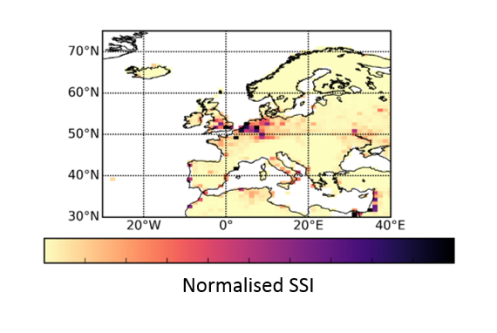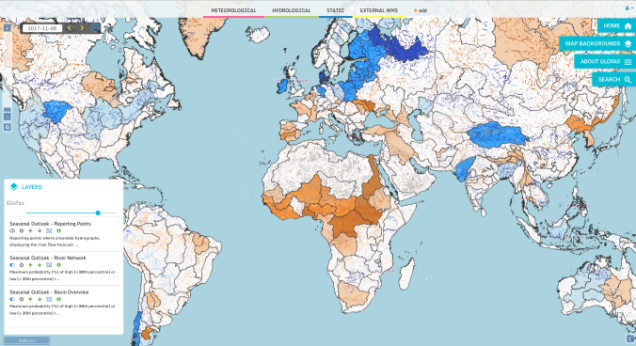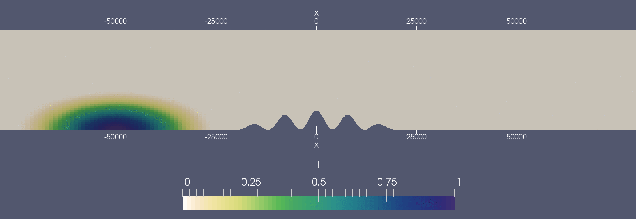All clouds within our atmosphere are charged to some extent (Nicoll & Harrison, 2016), caused by the build-up of charge at the cloud edges caused by the charge travelling from the top of the atmosphere towards the surface. On the other hand, nearly all convective clouds are actively charged, caused by charge separation mechanisms that exchange charge between different sized hydrometeors within the cloud (Saunders, 1992). If these actively charged clouds can separate enough charge, then electrical breakdown can occur in the atmosphere and lightning can be initiated.
As lightning is a substantial hazard to both life and infrastructure, understanding the processes that cause a cloud to become charged are crucial for being able to forecast it. Even though most convective clouds within the UK are charged, most will never produce lightning. This puts us in a unique position of observing clouds which can and cannot produce lightning, providing a contrast of the cloud processes involved.

Currently, lightning must be observed before the identification of a thunderstorm can be made, leaving zero lead time. As the first lightning strike can often be the most powerful, (especially in UK winter thunderstorms), improvements to understand the processes that charge a cloud are important to provide a thunderstorm lead time.
There are many processes involved in charging a cloud, a summary of the processes that are thought to have the greatest contribution can be found in Figure 1. The separation of charge through collisions is thought to be the dominant electrification mechanism which occurs in the ice phase of the cloud. The most successful charge separation occurs between growing ice hydrometeors of different sizes (Emersic & Saunders, 2010). The growth of the ice forms an outer shell of supercooled liquid water which contains negative charge. Collisions between different sized hydrometeors cause a net exchange of mass and charge, creating positively and negatively charged ice.
The liquid phase is crucial to maintaining a high moisture content in the ice phase of the cloud brought up by the updraught of the cloud. Once the electric field within the cloud is strong enough, the liquid drops can become polarised which can also help separate charge from collisions of different sized liquid hydrometeors in the later stages of convective cloud development.
Once the charge has been separated, the different polarities must be moved to different regions of the cloud to enhance the electric field. The most well-established method involves gravitational separation (Mason & Dash, 2000). Under the assumption that smaller hydrometeors will often contain negative charge and larger hydrometeors will contain positive charge, there is a distinct separation of hydrometeor sizes. After the formation of an updraught, the smaller hydrometeors can be lifted higher into the cloud overcoming the gravitational forces. Under the right conditions, the larger hydrometeors will be too heavy, and gravity will force the hydrometeors to remain lower in the cloud.

To understand if any of the processes discussed in Figure 1 are evident within real-world convective clouds, a field campaign was set-up at Chilbolton Observatory (CO) to measure the properties of the cloud. Two electrical instruments were installed at CO, the Biral Thunderstorm Detector (BTD-300, Figure 2a) and the electrostatic Field Mill (FM, Figure 2b) which can measure the displacement current (jD) and the potential gradient (PG) respectively. The 35GHz “Copernicus” dopplerised radar was used to measure the properties of the cloud. Through a two-year field campaign, 653 convective clouds were identified over CO, with 524 clouds (80.2%) found to be charged and 129 clouds (19.8%) found to be uncharged.
To understand the importance of hydrometeor size for charging a cloud, the 95th percentile of the radar reflectivity (Z) was used. The Z is strongly related to the diameter (sixth power) and number concentration of hydrometeors (first power). Figure 3 shows a boxplot of all 653 clouds, classified by the cloud charge as measured at the surface. For each cloud, the liquid and ice regions were separated (purple and blue boxplots respectively) to highlight the dominant region for charge separation.

For all phases of the cloud, there was a substantial increase in the reflectivity for all regions of the cloud, especially the liquid phase. This suggests that the size of the hydrometeors in both the ice and liquid phase are indeed important for charging a cloud.
In the remainder of my PhD, the relative importance of each process discussed in Figure 1 will be addressed to try and decouple each process. Further to these observations made at the surface, ten radiosonde flights will be made (from the Reading University Atmospheric Observatory) inside convectively charged clouds. Measurements of the charge, optical thickness, amount of supercooled liquid water and turbulence will be used to increase the robustness of the results presented in the previous works.
Email: james.gilmore@pgr.reading.ac.uk
References
Bouniol, D., Illingworth, A. J. & Hogan, R. J., 2003. Deriving turbulent kinetic energy dissipation rate within clouds using ground-based 94 GHz radar. Seattle, 31st International Conference on Radar Meteorology.
Emersic, C. & Saunders, C. P., 2010. Further laboratory investigations into the Relative Diffusional Growth Rate theory of thunderstorm electrification. Atmos. Res., Volume 98, pp. 327-340.
MacGorman, D. R. & Rust, D. W., 1998. The Electrical Nature of Storms. 1st ed. New York: Oxford University Press.
Mason, B. L. & Dash, J. G., 2000. Charge and mass transfer in ice–ice collisions: Experimental observations of a mechanism in thunderstorm electrification. J. Geophys. Res., Volume 105, pp. 10185-10192.
Nicoll, K. A. & Harrison, R. G., 2016. Stratiform cloud electrification: comparison of theory with multiple in-cloud measurements. Q.J.R. Meteorol. Soc., Volume 142, pp. 2679-2691.
Renzo, M. D. & Urzay, J., 2018. Aerodynamic generation of electric fields in turbulence laden with charged inertial particles. Nat. Comms., 9(1676).
Saunders, C. P. R., 1992. A Review of Thunderstorm Electrification Processes. J. App. Meteo., Volume 32, pp. 642-655.



 As a student, being an RMetS member can lead to conversations that could develop your career and bring unexpected opportunities. This has been greatly enhanced with the RMetS mentoring scheme.
As a student, being an RMetS member can lead to conversations that could develop your career and bring unexpected opportunities. This has been greatly enhanced with the RMetS mentoring scheme. For a student, the highlight in the RMetS calendar is the annual student conference. Every year, sixty to eighty students come together to present their work and develop professional relationships that continue for years to come. This year’s conference is hosted at the University of York on the 5th and 6th July 2018 (
For a student, the highlight in the RMetS calendar is the annual student conference. Every year, sixty to eighty students come together to present their work and develop professional relationships that continue for years to come. This year’s conference is hosted at the University of York on the 5th and 6th July 2018 ( Other benefits to becoming an RMetS student member include eligibility to the
Other benefits to becoming an RMetS student member include eligibility to the 
 Over the past months, researchers in the
Over the past months, researchers in the 































